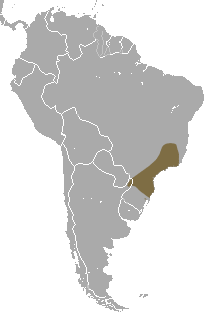Brazilian narrow-pouch rat
| Brazilian narrow-pouch rat | ||||||||||||
|---|---|---|---|---|---|---|---|---|---|---|---|---|

Brazilian small pouch rat ( Gracilinanus microtarsus ) |
||||||||||||
| Systematics | ||||||||||||
|
||||||||||||
| Scientific name | ||||||||||||
| Gracilinanus microtarsus | ||||||||||||
| ( Wagner , 1842) |
The Brazilian narrow- pouch rat ( Gracilinanus microtarsus ) lives in the east and southeast of Brazil from the center of Bahia in the north to the north of Rio Grande do Sul and to the southwest to the extreme northeast of Argentina ( Misiones province ).
description
The animals reach a head trunk length of 6.7 to 18.5 cm and have a 7 to 17.7 cm long tail and reach a weight of 12 to 58 g. The tail is 135% of the length of the head. The skull of the males is larger than that of the females. The back and sides of the body are solid red-brown. The hair is about 10 mm long and soft, gray at the base and red-brown at the top. The head is the same color as the back. The eyes are surrounded by dark circles from which runners extend to the nose and the bases of the ears. The ears are relatively large with a length of more than 21 mm, slightly transparent, orange at the base and brown at the tip. The peritoneum is whitish, cream-colored, yellowish or light brown. The feet are cream or whitish. The tail is usually two-tone with a dark top and a light underside. However, there are also populations with monochrome tails. Females do not have a pouch. The number of teats is 13, six each on the right and left and one in the middle. The Brazilian narrow-pouch rat has a chromosome set of 2n = 14 chromosomes with a variable number of arms (fundamental number, FN) of 20 or 24.
Habitat and way of life
The Brazilian narrow-pouch rat occurs in the Atlantic rainforest and the adjacent cerrado from sea level to altitudes of 1,800 meters. It is adaptable and also lives in secondary forests, in small forest fragments and eucalyptus plantations . It is nocturnal, solitary and climbs mainly high in the trees, less often in the undergrowth. The animals can cope with the distance between branches that are close together in jumps. The area inhabited by an individual is approximately 0.5 hectares. More than 500 specimens can live in one square kilometer of forest.
nutrition
The Brazilian narrow-pouch rat feeds mainly on invertebrates. These include beetles , Schnabelkerfe , ants and other hymenoptera , termites , grasshoppers , butterflies and caterpillars, as well as arachnids and snails. The seeds of Clidemia , Miconia , as well as of various myrtle plants , sandalwood plants and sturgeon plants were found in the faeces of the animals . The Brazilian narrow-pouch rat probably has an important role in the seed dispersal of these plants.
Reproduction
For reproduction, the females build nests in tree hollows from dry, fresh leaves. Occasionally, woodpecker holes or artificial nest boxes are also used. The nests are built from September to November at the beginning of the rainy season and are only used to raise the young, which takes place between September and May during the time of maximum rainfall. Usually nine to twelve pups are born.
Systematics
The author of the first description of the Brazilian narrow- pouch rat is the German zoologist Johann Andreas Wagner , who described it in 1842 under the name Didelphis microtarsus . Later it was placed in the genus of the dwarf sac rats ( Marmosa ) and today it belongs to the genus Gracilinanus , which was introduced in 1989 by the American mammalogen Alfred L. Gardner and his colleague G. Ken Creighton. The species is genetically very variable and has three distinctly different phenotypes . However, combined analyzes of the genetic and morphological characteristics do not yet give a conclusive picture, so it is still considered as a single species.
status
The Brazilian narrow-pouch rat is considered safe by the IUCN . It is common, occurs in various protected areas and changes in its habitat that are not too extensive by humans are usually tolerated.
literature
- Mathias M. Pires, Eduardo G. Martins, Maria Nazareth F. Silva & Sergio F. dos Reis: Gracilinanus microtarsus (Didelphimorphia: Didelphidae), in Mammalian Species 42 (851): 33-40 July 2008, DOI: 10.1644 / 851.1
- Smith P: Brazilian gracile opossum Gracilinanus microtarsus - Fauna Paraguay - Handbook of the Mammals of Paraguay, Number 42, 2012 PDF
supporting documents
- ↑ a b c d e f g Diego Astúa: Family Didelphidae (Opossums). in Don E. Wilson , Russell A. Mittermeier : Handbook of the Mammals of the World - Volume 5. Monotremes and Marsupials. Lynx Editions, 2015, ISBN 978-84-96553-99-6 . Page 172 a. 173.
- ↑ gracilinanus microtarsus in the endangered Red List species the IUCN 2016 Posted by: Brito, D., Astua de Moraes, D., Lev, D. & Soriano, P., 2016. Accessed January 23, 2020th
